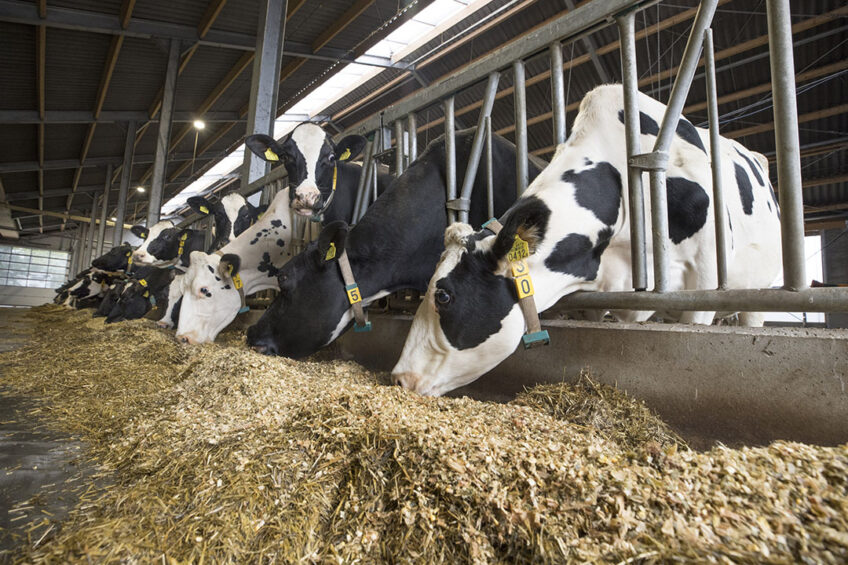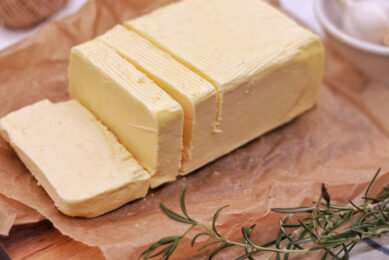Dairy rations to alleviate milk fat depression

Milk fat depression is a metabolic syndrome often observed in high yielding dairy cows in early and mid-lactation.
The main reason for milk fat depression is the acid load in the rumen caused by a high accumulation of volatile fatty acids (VFA). VFAs are the primary energy source for ruminants produced directly from bacterial fermentation of carbohydrates (cellulose, hemicellulose, pectins, glucans, starch and sugars), fats and feed proteins. Maintaining milk fat content in high yield dairy cows while alleviating milk fat depression remains a challenge for the efficiency and profitability of modern dairies.
2 main considerations in dairy rations
1. Forage to concentrates ratio regulates VFA production
Forages to concentrate ratio on dry matter should remain not lower than 45% to 55% for the first stage of lactation. Forages compared to concentrates have a higher proportion of structural carbohydrates, mainly neutral detergent fibre (NDF). Check for a total minimum NDF level of 32% of dry matter intake with min forage dry matter intake of 1.5% of a cow’s body weight. Structural carbohydrates (cellulose, hemicellulose, lignin and a portion of the pectin), fermented to acidic acid (AA) by cellulolytic bacteria in a rumen pH range between 7-6, play an important role in maintaining rumen pH above 6. Ammonia absorption is higher at pH levels above 6. Cellulolytic bacteria can define as much as 80% of metabolisable protein of cow requirements playing an important role in dietary protein metabolism.
Starch and sugars fermented to propionic acid by amylolytic bacteria push rumen pH towards a range of 6-5, with acetic acid (60% of the total VFAs) being the main precursor for liposynthesis, therefore promoting fatty acid synthesis in the mammary gland (milk fat). Propionic acid (20% of VFAs) provides energy through its conversion to blood glucose in the liver and stimulates lactose synthesis throughout lactation. It is important to look for a balance between high soluble and degradable feedstuffs with others of lower solubility and degradability.
2. Fatty acid content of feedstuffs
Milk fat (%) can regulate the final milk price for the farmer. Milk production (in kg) should be converted to a fat-corrected milk basis to evaluate the feed ration energy output in milk. A herd averaging 30kg of milk produced with 3.30% fat is the same as a herd with 27kg of milk produced with 3.95% fat. The 4% fat-corrected milk value is 26.5kg of milk for both herds. The producer with the lower milk fat (%) may sometimes get paid more for the milk produced depending on the monthly fat differential but in the long-term, more health-related problems and decreased milk production may follow for cows under milk fat depression.
Although fat should be at least 3% of dry matter intake, special focus should be given to the fatty acids profile of feedstuffs in the ration. The higher the content of long-chain fatty acids or unsaturated fatty acids (mono- and polyunsaturated) the higher the risk for milk fat depression. Polyunsaturated fatty acids (PUFA) are mainly omega-6 (corn > SBM > SFM > distillers grains > corn silage) often responsible for inflammatory response compared to ant-inflammatory response of omega-3 (alfalfa > grass > linseed). Because of their antioxidant activity to rumen bacteria, biohydrogenation of unsaturated fatty acids takes place in order to ferment further to VFAs. During alter pathways of the fermentation process, certain isomers produced stimulating further milk fat depression.
Trans-10,cis-12 conjugated linoleic acid (CLA-isomer) is one of the multiple biohydrogenation intermediates known to inhibit milk fat synthesis in the mammary gland via downregulation of genes related to fatty acid transport and synthesis (Harvatine et al., 2009a). Other known isomers are Trans-9 / cis-11 (Penfield et al. 2007), Trans-10 / cis-12 (Bundgaard et al. 2000), Cis-10 / trans-12 (Saebo et al. 2003).
Short-chain fatty acids or saturated fatty acids (such as palmitic, myristic, stearic acid), are better promoted in rumen-protected forms rather than slow-release forms. This is because the high concentration of fat in the rumen can significantly lower fibre degradability by rumen bacteria. Any additional polysaturated fatty acids can be introduced to the ration only in protected-coated forms to support fertility especially for high yield cows and especially in the first phase of the lactation cycle.
Conclusion
Milk fat depression is caused and regulated by an interaction of many nutritional and management factors. In most cases, more emphasis should be given on feeding strategies including feeding system, feed ration and meal frequency that should follow a circadian rhythm! Rumen modulators and live yeast can promote anaerobic rumen phenomena and therefore improve conditions for better NDF fermentation. But, remember that cows consume kg of dry matter and not percentages (%), so always check nutrients (%) on the feed ration level but follow up dry matter intake in the barn!
The type and level of process for each feed additive and/or feedstuff can alter fermentation procedures. Balanced TMR and/or combinations of TMR-PMR can be powerful enough to regulate how fast nutrients reach the small intestine. Managing the intestinal flow of nutrients via balancing palatable and higher bioavailability feed ingredients can manage milk fat depression. Ration uniformity between long, medium and small feed particles, increase total feed palatability and reduce cow’s selection behaviour. Cows on totally grass-fed and/or raised on pasture-based systems, are more susceptible to milk fat depression as forage consumption based only via rapidly fermentable, low fibre grass while feeding times remains inconsistent and depend on individual cow’s behaviour.







